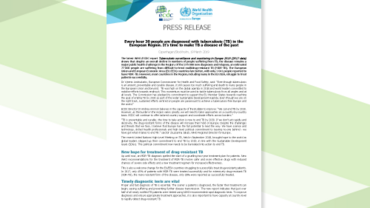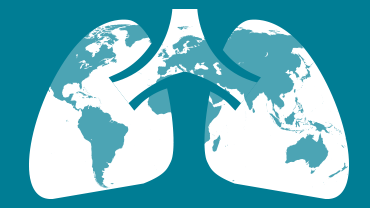Tuberculosis surveillance and monitoring in Europe, 2019
With just over 280 000 tuberculosis (TB) cases reported in 2017, TB remains a major public health problem in the WHO European Region, including the countries of the European Union/European Economic Area (EU/EEA). This report provides an overview of the latest TB epidemiological situation and is published jointly by the WHO Regional Office for Europe and the European Centre for Disease Prevention and Control (ECDC). It finds that epidemic patterns and trends vary widely, with the EU/EEA approaching the low incidence level of 10 per 100 000 population while the Region has nine out of 30 countries with the highest multidrug-resistant TB burden in the world. Overall, TB mortality and incidence rates have fallen. Despite the notable progress achieved in the fight against TB, countries still face a variety of challenges in reaching the goal to end the TB epidemic in the Region.
Executive Summary
European Union and European Economic Area
Epidemiology
In 2017, 55 337 cases of TB were reported in the 31 European Union and European Economic Area (EU/EEA) countries, resulting in a notification rate of 10.7 per 100 000 population in the EU/EEA. The overall notification rate and the rate in most countries has been decreasing over the last five years.
Of all notified TB cases, 39 903 (72.1%) were newly diagnosed and 37 700 (68.1%) were confirmed by culture, or smear and nucleic acid amplification test. Overall, adult age groups had a higher new and relapse TB notification rate than children under 15 years. Children under 15 years accounted for 4.4% of all new and relapse TB cases, corresponding to a notification rate of 2.9 per 100 000 population. The highest rates among 0–4-year-olds were noted in Bulgaria and Romania. For every female new and relapsed case of TB in the EU/EEA, almost two male new and relapsed cases were reported. Thirty-three per cent of all TB cases reported in the EU/EEA were of foreign origin, but 20% or less of TB cases from countries with TB notification rates higher than 10 per 100 000 population were reported as being of foreign origin.
MDR-TB was reported for 1041 (3.8%) of 27 339 cases with the relevant DST results and continues to be highest (more than 10%) in the three Baltic States. XDR-TB was reported for 24.3% of 770 MDR-TB cases tested for second-line drug susceptibility. After remaining at 0.3 per 100 000 population from 2013 to 2016, the rate of notified MDR-TB cases decreased to 0.2 in 2017. During the same period, the proportion of resistance to second-line anti-TB drugs increased among pulmonary MDR-TB cases. It should be noted, however, that in excess of 45% of these pulmonary XDR-TB cases were reported from Lithuania and Romania in those years.
Although the number of countries reporting data on HIV coinfection increased from 2016 to 2017, the data remain incomplete. Of all TB cases with reported HIV status, 3.9% were coinfected with the virus.
TB in prisons remains poorly reported. For the 15 EU/EEA countries reporting data, the notification rate amounted to 155 new and relapse TB cases per 100 000 inmates, that is, a relative risk of 11.4 compared to the general population in the same countries.
Treatment monitoring
Of all 54 612 TB cases notified in 2016 with a treatment outcome reported in 2017, 70.7% were treated successfully and 7.3% died. Of 1217 MDR-TB cases notified in 2015 with a treatment outcome reported in 2017, 44.8% were treated successfully and 16.2% died.
Download

EU/EEA country profiles
Publication data
Country profile
All country profiles, 2017 tuberculosis data
All country profiles based on 2017 surveillance data.
Infographic
Infographic: Tuberculosis in the EU/EEA 2017
Tuberculosis cases per 100 000 population EU/EEA 2017
Map
Map: Tuberculosis in the EU/EEA 2017
Map of tuberculosis cases per 100 000 population EU/EEA 2017
Map
Treatment success as of 2017 in all TB cases
Tuberculosis surveillance and monitoring in Europe 2019-2017 data
Infographic
TB deaths, EU/EEA - SDG target
TB deaths, EU/EEA - SDG target
Map
Treatment success as of 2017 in MDR TB
Tuberculosis surveillance and monitoring in Europe 209-2017 data
Map
Treatment success as of 2017 in XDR TB
Tuberculosis surveillance and monitoring in Europe 2019-2017
Presentation
Presentation: Tuberculosis situation in the EU/EEA, 2017
Findings from the joint report Tuberculosis surveillance and monitoring in Europe by ECDC and WHO Regional Office for Europe.







